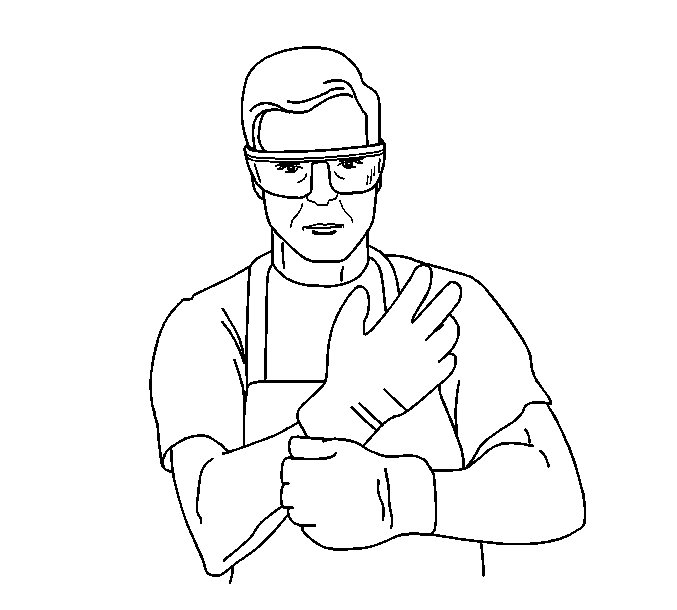- Verify all primers and urethane adhesive are within expiration
dates.
Caution: When replacing stationary windows, use Urethane Adhesive Kit GM P/N 12346392
(Canadian P/N 10952983), or a urethane adhesive system meeting GM Specification
GM3651G, to maintain original installation integrity. Failure to use the urethane
adhesive kit will result in poor retention of the window which may allow unrestrained
occupants to be ejected from the vehicle resulting in personal injury.
- Inspect the following components for the causes of a broken
rear window:
| • | The flange of the rear window opening |
| • | The rear window reveal molding |
- Inspect for any of the following concerns in order to help prevent
future breakage of the rear window:
| • | Hardened spot weld sealer |
| • | Any other obstruction or irregularity in the pinchweld flange. |
Important: If corrosion of the pinchweld flange is present, or if sheet metal repairs
or replacements are necessary, refinish the pinchweld flange in order to
present a clean primer only surface. If paint repairs
are required, mask the flange bonding area prior to
the application of the color coat in order to
provide a clean primer only surface. Materials such as
BASF DE17®, DuPont 2610®, Sherwin-Williams
PSE 4600 and NP 70 and Martin-Semour
5120 and 5130 products are approved for this application.
- After repairing the opening as indicated, perform the following steps:
- Inspect the condition of the rear window opening and the urethane
adhesive bead in order to determine which installation method you will
use. Refer to
Short Method Description
or
Extended Method Description
for
the guidelines.
- Remove all traces of broken glass from the vehicle.
- Clean around the edge of the inside surface of the rear window
with a 50/50 mixture of isopropyl alcohol and water by volume on a dampened
lint-free cloth.
- After repairing the opening as indicated, shake the pinchweld
primer (black #3) for at least one minute.
Caution: Failure to prep the area prior to the application of primer
may cause insufficient bonding of urethane adhesive. Insufficient bonding
of urethane adhesive may allow unrestrained occupants to be ejected from
the vehicle resulting in personal injury.
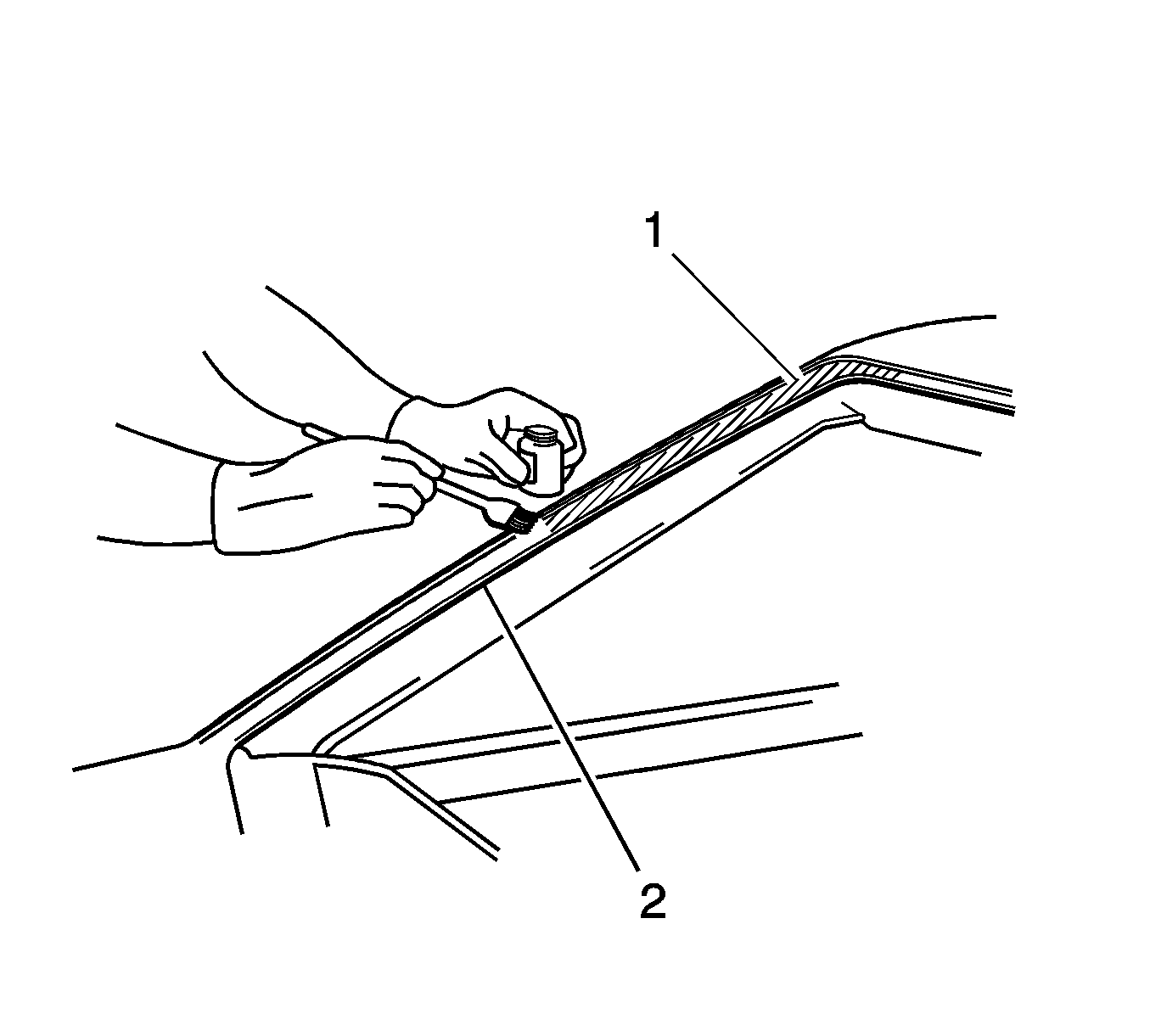
- Use a new dauber to apply
the pinchweld primer (black #3) to the surface (1) of the bonding
area on the body only.
- Allow the primer to dry for approximately 10 minutes. Ensure
that all nicks and scratches are covered.
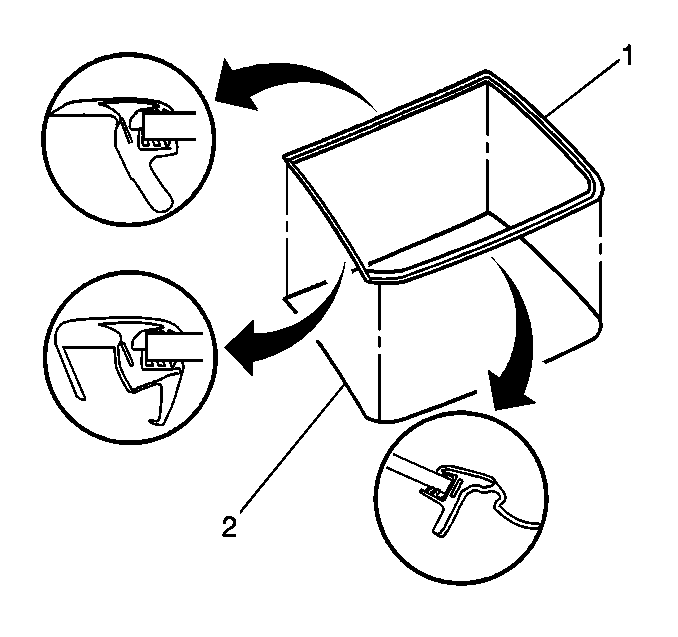
- If the original reveal
molding is damaged it must be replaced, if equipped.
Install
the new rear window reveal molding (1). Refer to
Rear Window Reveal Molding Replacement
.
- Start from the center and hand press the rear window reveal molding (1)
onto the rear window (2).
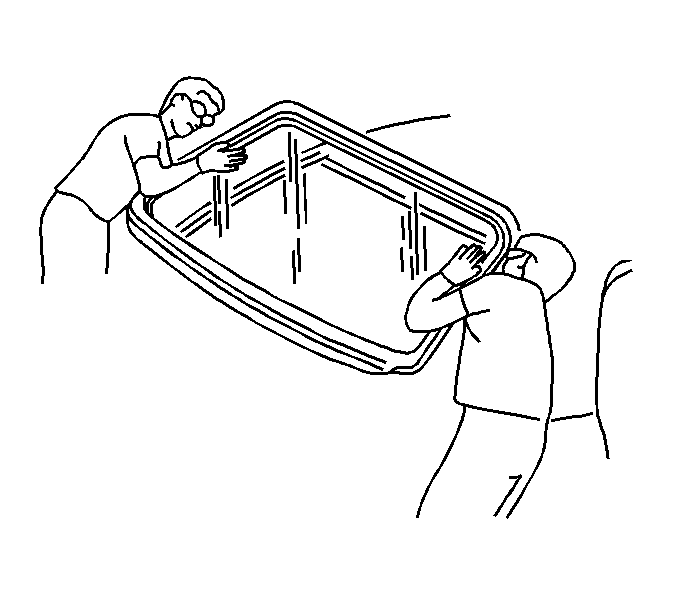
- With the aid of an assistant,
dry fit the rear window in the opening in order to determine the correct
way to position the rear window in the opening.
- Use masking tape in order to mark the location of the rear window
in the opening.
- Slit the masking tape at the top edge of the rear window.
- With the aid of an assistant and the suction cups, remove the
stationary window.
- Place the stationary window inside up on a clean, protected surface.
- If you reuse the rear window, remove all but approximately 2 mm
(3/64 in) of the existing urethane adhesive from the rear
window surface, using a utility knife or
razor blade scraper.
Important: Do not remove all traces of the adhesive. Remove all mounds or loose
pieces of the urethane adhesive.
- If the extended installation method is being used remove all but approximately
2 mm (3/64 in) of the existing bead of adhesive from the pinchweld
flange.
- Clean around the edge of the inside surface of the window with
a 50/50 mixture of isopropyl alcohol and water by volume on a dampened
lint- free cloth.
Important: Do not apply the (black #3) primer to the existing bead of the
urethane adhesive. Apply only to nicks, scratches or the primed surfaces.
- Shake the pinchweld primer (black #3) for at least one minute.
- Use a new dauber in order to apply the primer to the surface of
the pinchweld flange.
- Allow the glass primer to dry for approximately 10 minutes.
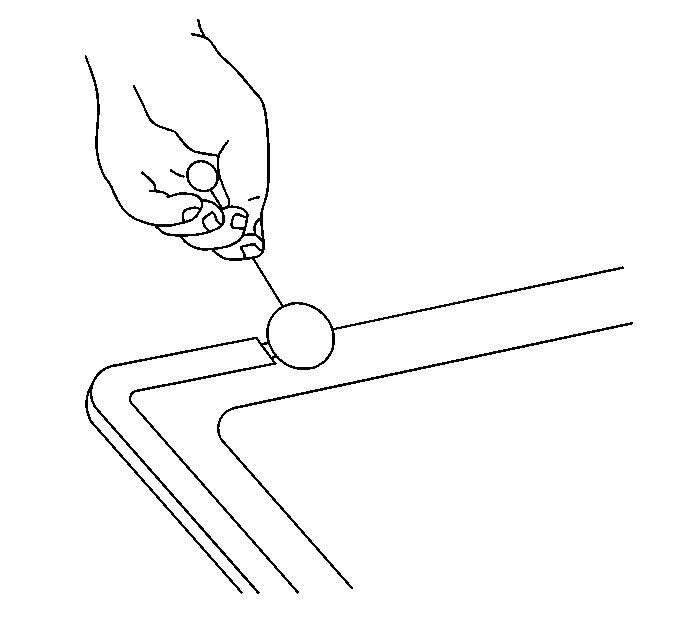
Important: Use care when applying the stationary window prep (clear #1)
to the rear window. This primer dries almost instantly and may stain the
viewing area of the rear window if not applied evenly.
- If installing a new non encapsulated window:
| 24.1. | Use a new dauber, to apply the rear window prep (clear #1)
to an area approximately 10-16 mm (3/8-5/8 in)
around the entire perimeter of the rear glass inner surface. |
| 24.2. | Apply the rear window prep (clear #1) to the same area
of the glass. |
| 24.3. | Wipe the primed window area immediately with a lint-free cloth. |
| 24.4. | Shake the glass primer (black #2) for at least one minute. |
- If installing a new encapsulated window:
| 25.1. | Use a new dauber, to apply the window prep (clear #1) to
an area approximately 10-16 mm (3/8-5/8 in)
around the entire perimeter of the glass inner
surface The glass must be installed within 8 hours
after applying the primer to the glass. |
| 25.2. | The primed surface of the glass must be kept clean. |
| 25.3. | Allow the glass primer to dry for approximately 10 minutes. |
- Shake the stationary window primer (black #2 ) for at least
one minute.

- Use a new dauber, in order
to apply the rear window primer (black #2) to the areas of the rear
window (1) to which prep (clear #1) was applied.
- Allow the primer to dry for approximately 10 minutes.
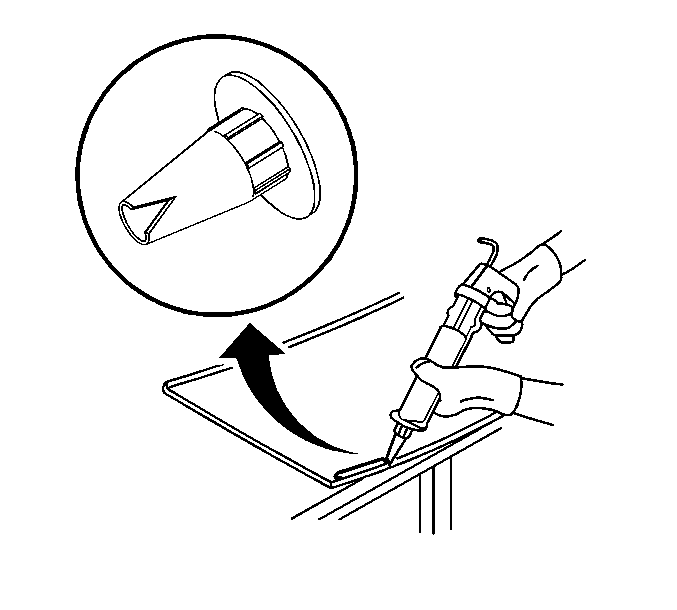
- If using the short method,
cut the tip of the applicator nozzle in order to provide a bead of 6.0 mm
(1/4 in).
- If using the extended method, cut the applicator nozzle in order
to provide a bead 10.5 mm (0.14 in) wide and 10.5 mm (0.14 in)
high.
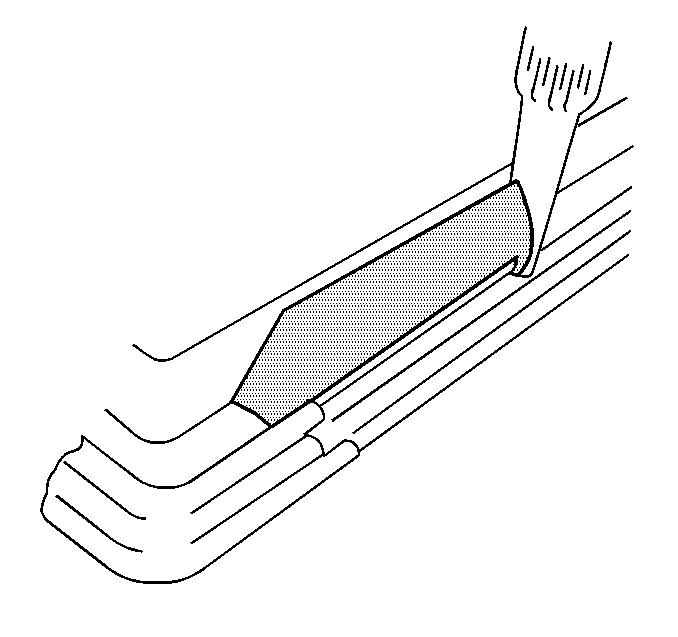
- Use a cartridge-type caulking
gun, apply a smooth continuous bead of new urethane adhesive around the edge
of the rear window where the primer was applied.
- When using the short method, apply the urethane adhesive to the
existing bead of urethane adhesive on the body.
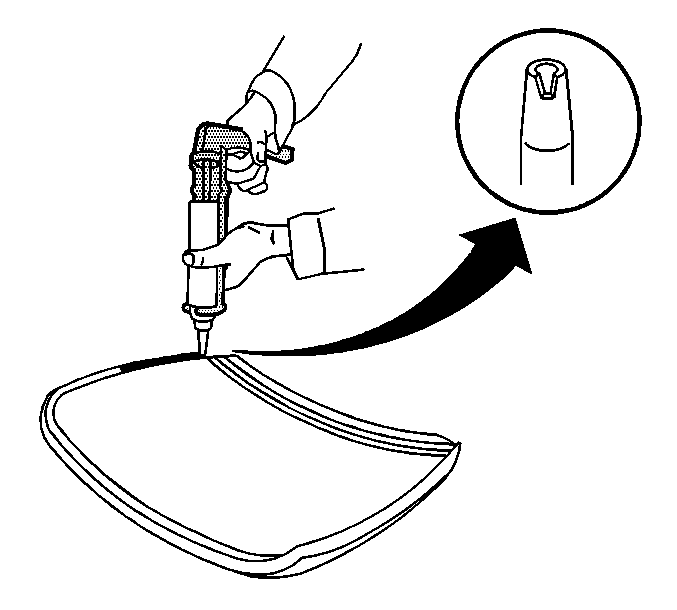
- When using the extended
method, use the edge of the rear window or the inside edge of the reveal
molding as a guide for the nozzle in order to apply the urethane
adhesive to the inner surface of the rear window.
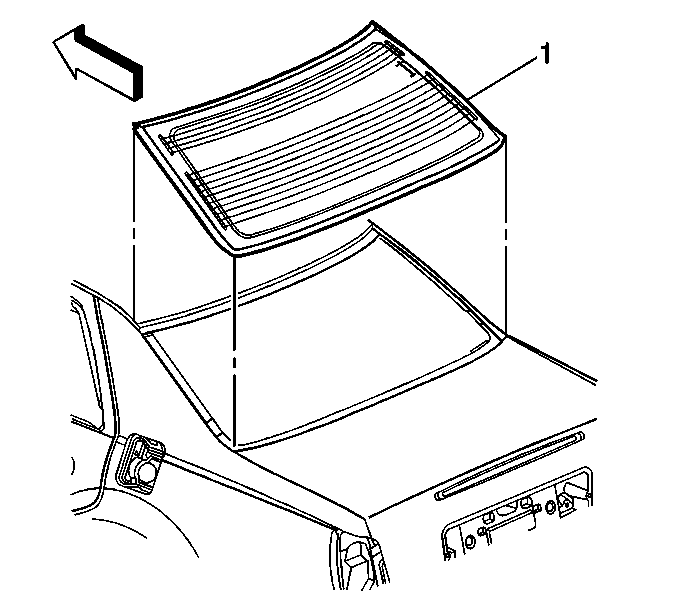
- With the aid of an assistant,
use the suction cups in order to install the rear window (1)
into the opening.
- Align the tape on the rear window and on the body.
- Press the rear window firmly into place in order to wet-out and
seat the urethane adhesive.
- Tape the rear window in two places to the body in order to minimize
movement until the urethane adhesive cures.

- Clean any excess urethane
adhesive from the body.

Important: Do not direct a hard stream of high pressure water at the fresh urethane
adhesive.
- Use a soft spray of warm water in order to immediately water test the
rear window.
- Inspect the rear window for leaks.
- If any leaks are found, use a plastic paddle in order to apply
extra urethane at the leak point.
- Retest the rear window for leaks.
Caution: Insufficient curing of urethane adhesive may allow unrestrained occupants
to be ejected from the vehicle resulting in personal injury.
| • | For the moisture-curing type of urethane adhesive, allow a minimum
of 6 hours at 21°C (70°F) or greater and with at least 30 percent
relative humidity. Allow at least 24 hours for the complete curing
of the urethane adhesive. |
| • | For the chemical-curing type of urethane adhesive, allow a minimum
of 1 hour . |
- The following conditions must be maintained to properly
cure the urethane.
| 43.1. | Partially lower a door window in order to prevent pressure build-ups
when closing the doors before the urethane adhesive cure. |
| 43.2. | Do not drive the vehicle until the urethane adhesive is cured.
Refer to the above curing times. |
| 43.3. | Do not use compressed air in order to dry the urethane adhesive. |
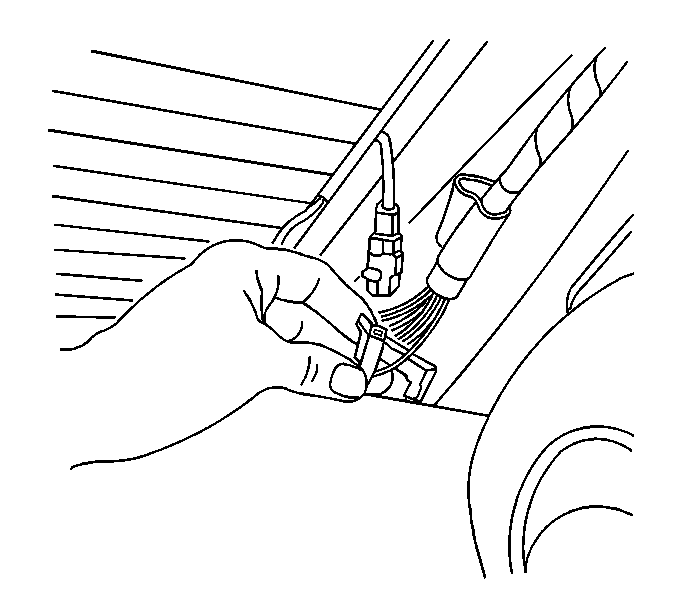
- Connect the rear window
electrical connectors.
- Install the headliner. Refer to
Headlining Trim Panel Replacement
in Interior Trim.
- Install the rear quarter trim panels. Refer to
Rear Quarter Upper Trim Panel Replacement
in Interior Trim.
- Install the rear seat back. Refer to
Rear Seat Back Replacement
in Seats.
- Install the rear seat cushion. Refer to
Rear Seat Cushion Replacement
in Seats.
- Install the OnStar antenna. Refer to
Mobile Telephone Antenna Inner Coupling Replacement
or
Mobile Telephone Antenna Outer Coupling Replacement
in Cellular Communication.
- Close the rear compartment lid.
- Remove the protective coverings and tape from the vehicle and
the headliner.


